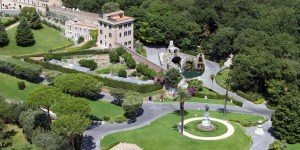Located within the walls of Vatican City, the Vatican Gardens offer a tranquil escape from the hustle and bustle of the Eternal City. These private urban gardens and parks cover more than half of the whole Vatican territory – approximately 23 hectares (57 acres).
The origins of the Vatican Gardens can be traced back to 1279, when Pope Nicholas III moved his papal residence from the Lateran Palace to the Vatican. He commissioned the creation of an orchard, lawn, and garden, transforming a previously swampy area into a verdant retreat.
Over the centuries, successive popes expanded and improved the gardens, thus reflecting the horticultural trends of their time.
One of the most significant developments occurred under Pope Julius II in the early 16th century. Known for his patronage of the arts, Pope Julius II enlisted the talents of renowned artists and architects to redesign the gardens. This era saw the introduction of Renaissance elements, including geometric flower beds, fountains and sculptures, many of which still grace the gardens today. The famous Belvedere Courtyard, designed by Donato Bramante, is a striking example of the influence of this period.
The Vatican Gardens serve many purposes. First and foremost, they are a place of rest and reflection for the pope and the Vatican’s clergy. Amid the lush greenery of towering trees, colorful flowers, and tranquil fountains, one can find a peaceful environment conducive to prayer and contemplation. The gardens also contain a variety of plants from around the world – a floral reminder of the universal nature of the Catholic Church.

There is certainly a spiritual element to the Gardens even beyond the beauty of nature. A number of statues and images bring to mind important devotions of the universal Church.
Recent additions have included a statue of St. Gregory of Narek, a newly proclaimed Doctor of the Church and central figure for Armenians; Our Lady of the Rosary of Chiquinquirá, the patroness of Colombia; and Our Lady of Charity, the patroness of Cuba.
Habitats for wildlife
The gardens are also an important ecological space within the Vatican. They include a variety of habitats, such as lawns, flower beds, and wooded areas, which provide a sanctuary for numerous species of birds and small animals that would otherwise not thrive in a city as busy as Rome. This biodiversity underscores the Church’s commitment to environmental stewardship, incorporating the teachings of Pope Francis’ 2015 encyclical, Laudato Si’.
Located in the heart of Vatican City, the gardens are bordered by the Vatican Museums, St. Peter’s Basilica, and the Apostolic Palace. While primarily reserved for the pope and his guests, since 2000 the Vatican Gardens have been open to the public through guided tours, offering visitors a rare glimpse into this verdant oasis.
The Vatican Gardens are an important botanical collection, sure. But they are also a historical and spiritual sanctuary, embodying centuries of papal tradition, artistic achievement, and ecological awareness. For those fortunate enough to walk through these gardens, it is an experience that inspires peace, reflection, and a deeper connection to God’s creation.



